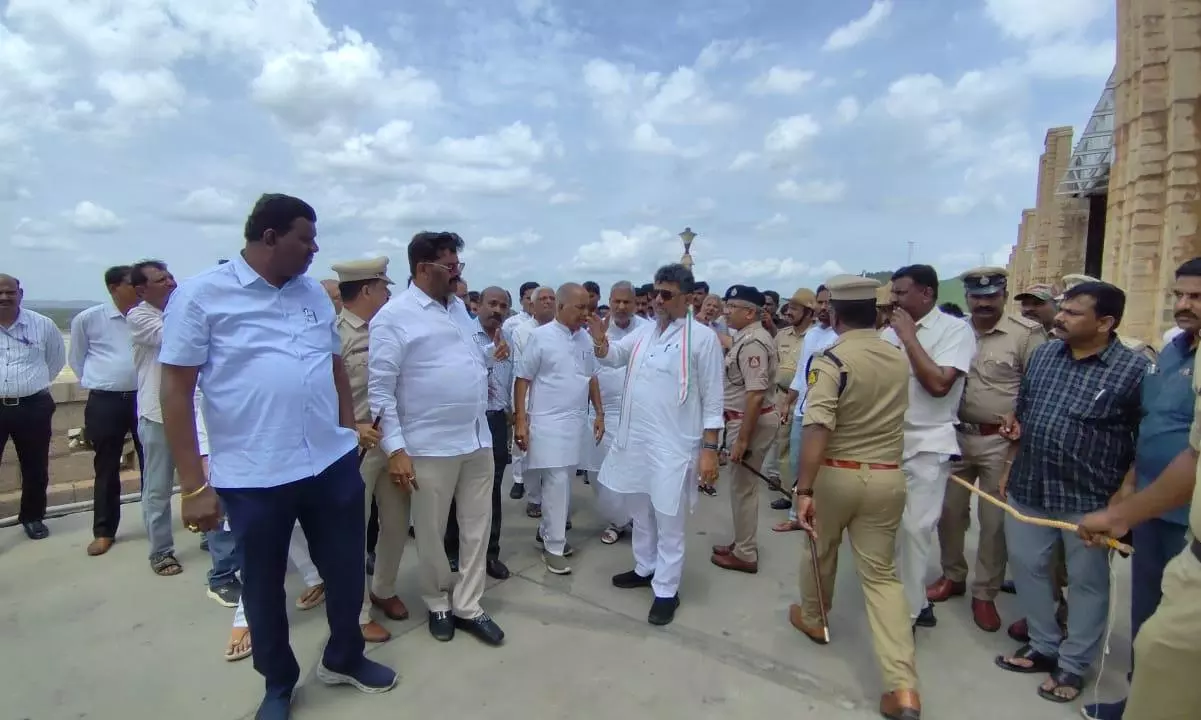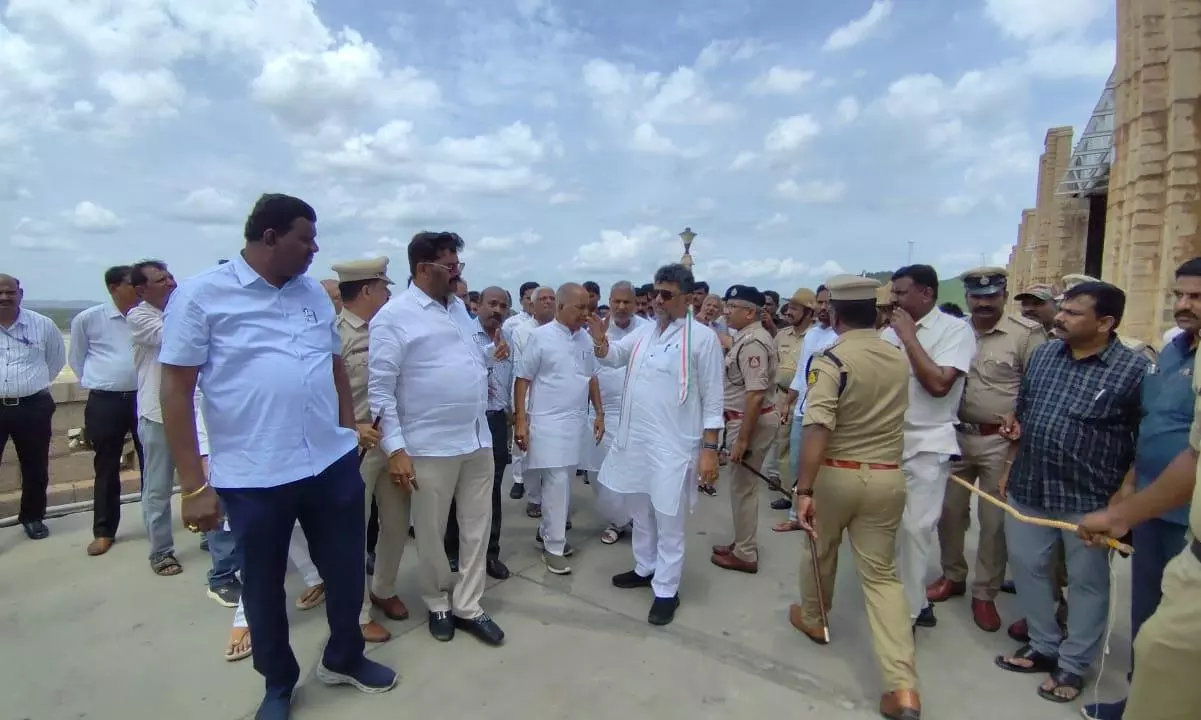
Hosapete: A spillway gate was washed away from the groove at the Tungabhadra Dam on Aug 10 night.
The Tungabhadra Project is an important multipurpose river project in South India. The dam, located in Karnataka, serves the people of Karnataka, Telangana and Andhra Pradesh. It plays an important role in irrigation of farmland, supports hydroelectric power generation, helps in flood control and supports drinking water supply.
On August 10, ten spillway gates, numbered 12 to 21, had been operated to a height of 1.5 feet, releasing 22,890 cusecs of water. At 10.50 pm the spillway gate No.19 was washed away from the groove of the spillway. Following the gate’s dislodgment, the Tungabhadra Dam Board immediately informed higher authorities, including disaster management officials in the districts of Ballari, Vijayanagar, Raichur, Koppal, and Kurnool.
“Action is being taken to fabricate a new stop log gate in consultation with the gate works expert Kannaih Naidu, who also submitted the design and drawings of stop log gate elements, meanwhile discussion has been made with the fabricators in the presence of dam authority, Managing Director, KNNL & Secretary, TB Board,” a press statement from the Tungabhadra Board Secretary stated.
In the afternoon Deputy Chief Minister DK Shivakumar who also holds the portfolio of irrigation and water resources rushed to inspect the Dam and assess the situation.
Accompanied by Minister for Minor Irrigation NS Boseraju, Minister for Backward Classes Welfare, Kannada, and Culture Shivraj Tangadagi, MP E. Tukaram, Vijayanagar MLA HR Gaviyappa, Koppal MLA Raghavendra Hitnal, and other public representatives, Shivakumar received a detailed briefing from officials on-site.
Addressing the media, Shivakumar stated that while the Central Water Commission (CWC) manages 16 gates of the dam, the Karnataka government is responsible for the maintenance of the remaining gates. He said that he has been in continuous contact with officials since the night of August 10 to monitor the situation. Discussions are ongoing to retain water for the three states dependent on the dam while ensuring that repairs are carried out on the damaged gate.
In light of safety concerns, all gates of the dam have been opened to allow water to flow into the river. “We care about the farmers and respect their suggestions. Ultimately, actions will be taken based on the expert report,” Shivakumar added.
Describing the incident as “extremely unfortunate,” he announced that experts are being brought in to repair the damaged Spillway Gate No. 19 at the Tungabhadra Dam.
He assured that the Tungabhadra Irrigation Corporation has skilled engineers, and teams from contractor companies have already initiated the work. “The design blueprint of the dam has been provided to the technicians,” he added.
Shivakumar explained that on Saturday night, 10 gates of the dam were opened, and when the chain link of Gate No. 19 suddenly snapped, all gates were opened to reduce the pressure on the dam. Currently, 98,000 cusecs of water is being released from the reservoir, with 35,000 cusecs flowing out through Gate No. 19 alone. He reassured farmers that there is no need to panic.
“To install the new gate, we need to reduce the pressure by emptying 60 TMC of water from the reservoir. The dam can hold 150 TMC of water. We are currently receiving an inflow of 28,000 cusecs. We will retain enough water to ensure at least one crop for our farmers,” he declared.
Shivakumar further explained that 115 TMC of water is required to supply the major canals from the dam.
“We are working to ensure that our farmers are supported,” he said.
He added that already the neighboring states have been provided 25 TMC of water with 90 TMC still needed. The three states—Andhra Pradesh, Telangana, and Karnataka—are collaborating to resolve this issue. Farmers should not worry; we are here for them,” he stated.
Shivakumar highlighted the importance of the dam to the farmers of Andhra Pradesh, Telangana, and Karnataka, noting that Karnataka alone benefits from irrigating 12 lakh hectares in districts like Koppal, Raichur, and Ballari. “Our farmers need not worry; the government stands with you,” he assured.
“This dam is 60 to 70 years old, and I am not blaming any officials for the incident. Our priority is to protect the nation’s assets. We have restricted access to a two-kilometer radius around the dam, allowing only technicians and concerned officials while keeping even public representatives out,” he declared.
Shivakumar also announced that the event of offering ‘Baagina,’ scheduled for August 13, has been postponed due to the incident. “Safety of the dam is our top priority right now,” he explained.
When asked about the time required for repairs, he responded, “Our officials are working vigilantly every moment. They acted swiftly from the moment the incident occurred. This mishap was not due to anyone’s negligence; it happened accidentally.”
Regarding the inspection of other reservoirs, Shivakumar said, “Other reservoirs have both rope and chain systems. The Tungabhadra Dam was designed with a chain system. We will address the issues here first and then proceed to inspect other sites,” he added.
Chief Minister Siddaramaiah is scheduled to visit the reservoir on Tuesday for an inspection.
On Sunday, he spoke to the department’s Principal Secretary, Gaurav Gupta, and obtained all the details. He instructed that precautionary measures be taken to prevent any damage.
The Chief Minister also discussed the situation with Deputy Chief Minister DK Shivakumar, who is also the Minister for Water Resources, Vijayanagar District In-charge Minister Zameer Ahmed Khan, and Koppal District In-charge Minister Shivraj Tangadagi.
Downstream of Tungabhadra Dam, there are two barrages- Rajollibanda diversion scheme and Sunkesula barrages and their flood design capacities are 7.65 lakhs Cusecs & 2.08 Lakhs cusecs respectively. The present spillway discharge of TB dam is 85,156 Cusecs and total River discharge is 89,784 Cusecs and this discharge will not affect the downstream barrages/schemes.
Meanwhile the BJP leaders have expressed their concern over the incident.
“As people, who have been reeling under a prolonged drought, were just beginning to rejoice over the filled dam, the sudden malfunction of the crest gate has sparked concerns about the potential loss of stored water, which could severely impact future agricultural activities,” BJP state president BY Vijayendra posted on X.
“The negligence of officials responsible for maintaining such a massive dam is evident. I urge the government and district administration to immediately relocate the residents of flood-prone villages and take swift action to repair the dam’s crest gate,” he added.
Haveri MP and former chief minister Basavaraj Bommai said that the incident could have been avoided if the state government had taken the recommendations of the Dam Management Committee seriously.
He told reporters that the Tungabhadra Dam was constructed during the pre-independence era and has faced several issues over time. One of the major problems was the accumulation of silt. During the BJP tenure, a DPR was prepared to construct a parallel dam to address these issues. The Dam Management Committee, which was formed by the central government, provided several recommendations. The state government should have implemented these recommendations with priority. It seems like the government did not take these recommendations seriously. Had they considered them carefully, this situation could have been avoided,” he opined.
“Due to improper management, this issue has occurred. If an investigation is conducted, the truth will come out,” he noted.
According to officials in May 2024, comprehensive maintenance work was conducted on the gates, including the application of Cardium compound, greasing of chain bearings and plumber blocks, and oil filling in the Radicon gearbox units. The gates were thoroughly tested and confirmed to be in proper working condition by officials from the Tungabhadra Board, including the Secretary, Superintending Engineer, Executive Engineer, and Sub Divisional Officer.
